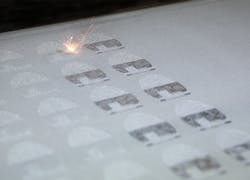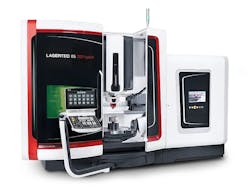Additive manufacturing continues to evolve
Additive manufacturing (AM), aka 3D printing, has grown rapidly since it was first introduced more than 30 years ago. In 1984, the first major patent for a 3D-printing process was awarded to Charles Hull, the inventor of stereolithography. Patents were awarded at about the same time to Stratasys, a company pioneering 3D extruded thermoplastic parts. A lot has happened within the industry since then.
Stereolithography was based on industrial lasers, as were a variety of later technologies for printing both polymers and metals.
Polymers
There are several technologies for building polymer parts. Vat photopolymerization (VPP) generally uses an ultraviolet (UV) light source to harden a photopolymer; heat can be used as an energy source as well. The VPP process, also known as stereolithography, uses a laser to cure a liquid resin layer by layer inside a build vat to form the object. Starting in 2002, Envisontec (now ETEC) introduced a system using a digital light processing (DLP) projector as an alternative light source to cure the photopolymer. These systems replaced laser-based stereolithography for certain applications. With some exceptions, DLP systems are used for building smaller parts than larger frame stereolithography. Small-part VPP is commonly used for a variety of dentistry applications.
A second major technology for polymer part production is powder bed fusion (PBF), or selective laser sintering (SLS). Laser energy melts layers of powdered polymer, fusing them together layer by layer to form parts (see Fig. 1). The most common material used for SLS is polyamide (PA) 12, also known as nylon. The output is fully functional with good material properties. Because the parts are being made from fused powder, the surface finish is rough and often requires post-processing such as smoothing or painting. In various industrial applications, SLS is a replacement for traditional injection-molded parts for smaller run sizes of up to tens of thousands of units, depending on the part design. Starting in 1987, the University of Texas at Austin spinoff DTM, acquired later by 3D Systems, pioneered the process.
Material extrusion (MEX) and material jetting (MJT) round out the picture of polymer 3D printing. The former, widely referred to as fused deposition modeling (FDM), builds parts by extruding heat-melted thermoplastics through a nozzle. The latter uses industrial inkjet technology to selectively jet photopolymers onto a build plate, cured by exposure to UV light. No laser technologies are used in these two processes.
Metals and ceramics
The making of functional metal and ceramic parts has developed significantly in recent years, because prices for the underlying technologies have come down. PBF is by far the most common metal AM process. Like its related process for polymers, a laser beam melts the metal powder inside an inert and heated build chamber to form the part. The build process achieves the melting point of the metal alloy being printed, and results in fusion of the powder into a functional metal part. Parts require support structures that must be removed after building is completed. As with polymer PBF, parts are fairly rough, because they are made from melted grains of powder and often require smoothing, polishing, or machining to achieve the desired surface finish. Heat treatment of parts is commonly needed to relieve stress that builds up during the PBF process. Hot isostatic pressing (HIP) is sometimes required to achieve full density for some applications. A wide range of materials can be used in this process, including aluminum, titanium, cobalt chrome, stainless steel, nickel-based superalloys, and copper.
Directed-energy deposition (DED) is a group of processes characterized by melting a metal feedstock into metal parts via a process similar to welding. The feedstock could be provided by a metal wire or metal powder, and the thermal heat source for melting the feedstock can be supplied by a laser or an electron beam (see Fig. 2).Alternatives to laser
Stereolithography was once a pioneering technology that relied on industrial lasers. Large-format stereolithography equipment is still in demand. Legacy manufacturing applications, such as those developed by Align Technologies and based on equipment supplied by 3D Systems, still churn out large numbers of AM parts. Align produces 700,000 dental arches per day. Large parts are also still an area where laser photopolymerization has an advantage.
However, laser-driven processes today face stiff competition from equipment with DLP or LED light sources. They are accurate enough to replace lasers and offer speed advantages by being able to expose an entire layer to the light source at one time. Laser polymerization, a vector process, is inherently slower. Inkjet printing of photopolymers also competes with lasers, although part size is limited, and material properties are limited by the need to jet only low-viscosity materials.
Laser-driven SLS faces competition from multijet fusion, an inkjet and infrared process developed and commercialized by HP. Similarly, high-speed sintering shows potential for functional nylon part production at costs lower than SLS parts.
On the metals side, laser PBF still has the lion’s share of the market, supported in much smaller quantities by some laser-driven DED technologies. Electron beam PBF is making progress, and a number of new players are entering the market. The latter accounts for only a small percentage of the metal AM installed base.
A more serious competitor to laser PBF is metal binder jetting. This technology offers the promise of lower-cost metal AM. Its growth has so far failed to live up to expectations, despite the entry of a number of new and well-funded companies into this technology. This could be attributed to process issues related to handling green parts and, more importantly, the difficulty customers have in efficiently sintering the parts. This secondary process is something laser PBF avoids.
AM encompasses a dynamic and growing set of technologies and materials. Exciting new developments by a growing number of suppliers reach the market each year, opening up new applications in areas where AM has an advantage. AM does not always make sense and accounts for a very small percentage of the manufacturing segment. But when it does make sense, it can offer unique solutions for added value to a growing number of use cases. The dynamism of this segment promises growth for years to come.
About the Author
Joseph Kowen
Principal Consultant, Intelligent AM
Joseph Kowen is a principal consultant at Intelligent AM (Israel), as well as a consultant for a variety of additive manufacturing companies.
Nigel Bunt
Principal Consultant, Intelligent AM
Nigel Bunt is a principal consultant at Intelligent AM (Israel), as well as a consultant for a variety of additive manufacturing companies.

